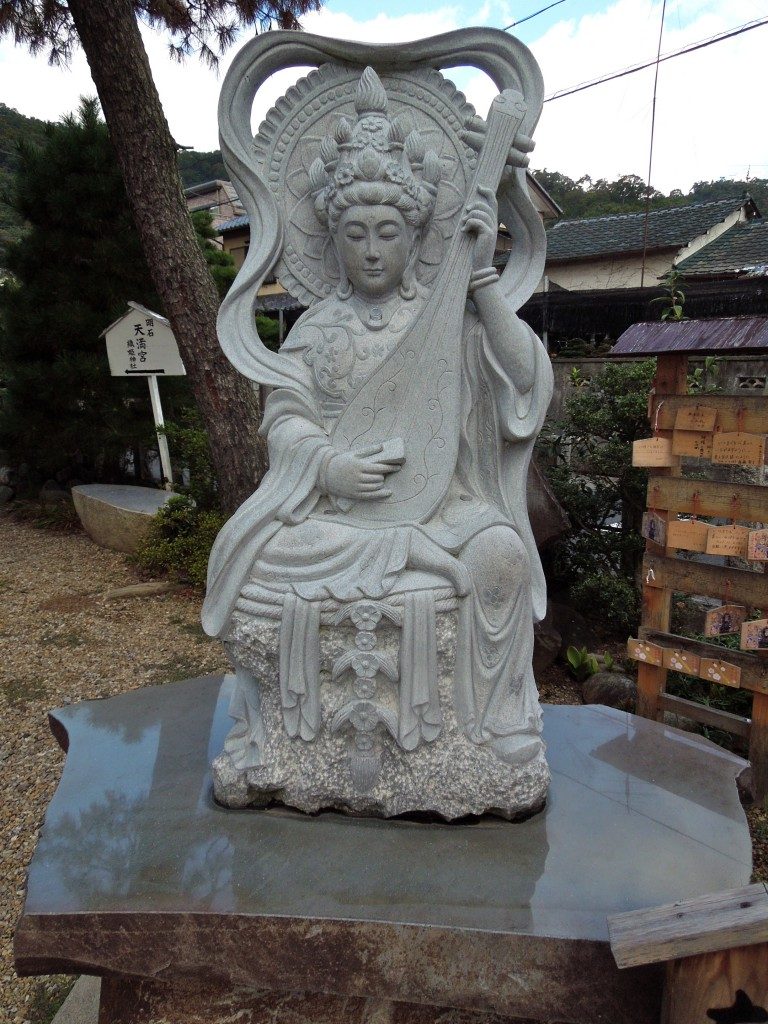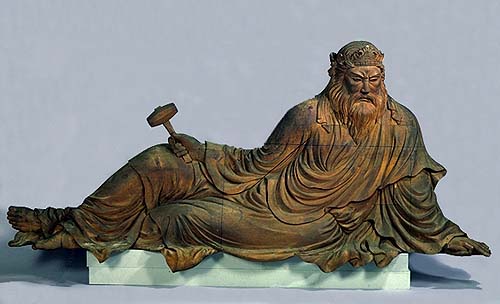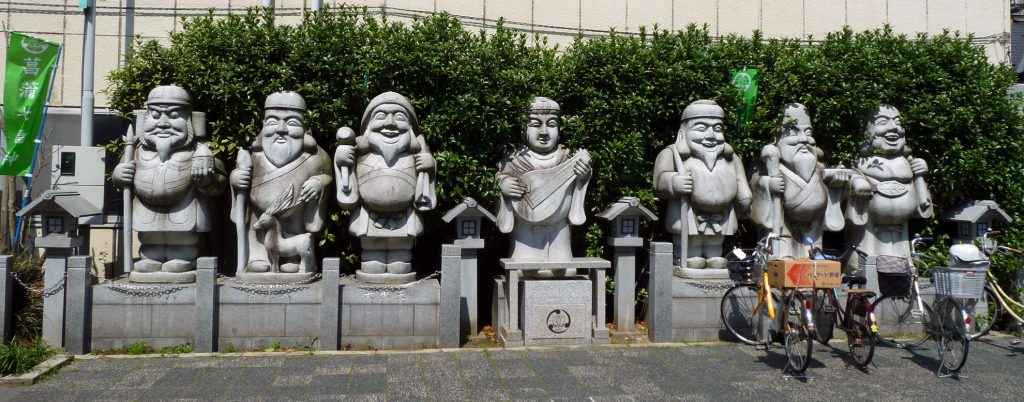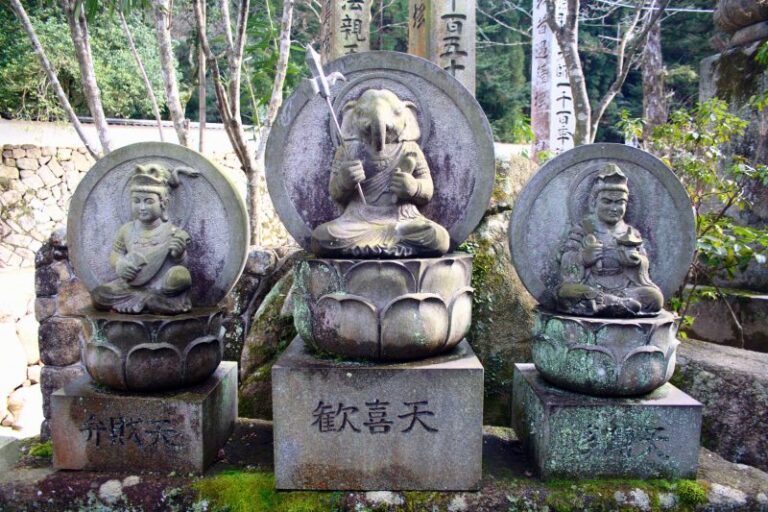Excerpts from the book Mysteries of the Ancient Vedic Empire by Stephen Knapp
Japanese scholar Okakura observes, in his Ideals of the East: “The religion and culture of China are undoubtedly of Hindu (Vedic) origin.”
Vedic tradition went from India to China and on to Japan. The practice of meditation, for example, was Ch’an in China and became Zen in Japan. However, some of these traditions also arrived in Japan through the sea route from Tamil Nadu. This explains how some Sanskrit terminology was adopted into Japanese through Tamil phonology, or why Sanskrit mantras are written in the Siddham script of South India. Sanskrit words such as homa – Vedic fire ritual and acharya – teacher became goma and achari, respectively, in Japanese. In Central Japan they observe the homa fire ceremonies, rub incense on their foreheads (similar to applying tilak) and consider Ganesh the remover of obstacles. Temples follow the basic Vedic design – a main hall before the sanctum and a circulatory path around them. Vedic devas have their Japanese counterparts!
Vedic Gods In Japan
The Shingon pantheon of Japan include Daikoku (Siva), Shoten sama or Kanjiten (Ganesh), Taishaku (Indra), Katen (Agni), Emma-o (Yama), Benzaiten or Benten (Sarasvati), Suiten (Varuna), Futen (Vayu), Ishana, Bonten (Brahma), Jiten (Prithvi), Nitten and Gatten (Surya and Chandra), among others. “Though most of the deities are venerated only as forming part of Mandara (mountain]), some of them such as Shoten sama, Emma-o, Suiten and Benten are popular objects of worship and have temples dedicated to them.” (Sir Charles Eliot, Japanese Buddhism, London, 1935, p.355). According to author Hisashi Nakamura, there is no country in the world other than Japan where students are taught the rudiments of Sanskrit. About 15 miles from the heart of Tokyo is a Vedic temple of Indra with two figures of Hanuman guarding the image. Large crowds also visit the temples of Saraswati and Fudo, a form of Shiva, who possesses a third eye, trident, and a lasso of snakes.
You can still recognize deities of Brahma, Shiva, Vishnu, Lakshmi, Durga, Ganesh, and others in the temples at Kyoto, Nara, Miyajima, and other places. Nara was a center of Sanskrit learning even earlier than 700 CE. Japanese temples have Sanskrit manuscripts, some of which are much older than those preserved in India. Furthermore, according to Japanese Shinto scholar Taka Kasu, Japan’s oldest religion was Brahman-okoyo, or Brahmanism, now known as Shintoism, the main religion of Japan today. Shinto centers around the belief in worship of natural forces and ancestors and also some Vedic gods, mentioned earlier. At the Kotohira shrine on the island of Shikoku, sailors worship Kompera, which is a corruption of the Sanskrit word Kumbhira (crocodile). The divine architect in the Rig Veda, Vishvakarma, was regarded in ancient Japan as the god of carpenters, Bishukatsuma. In Japan, the Kanjiten (Ganesh) cult was first mentioned in 806 and the images clearly reflect the deity’s Vedic origins., While the Indian deity is elephant-headed, Kanjiten may be depicted with an elephant’s head and human body, or a pair of two-armed, elephant-headed deities in embrace.


Mahayana Buddhism spread to China, Korea, Japan, and Vietnam, and with that came the basic Vedic pantheon of deities. Mahayana Buddhist scriptures were also in Sanskrit, while the earlier Theravadin texts were in Pali. You may also see Ganesh at some Buddhist temples, such as the popular temple at Futako Tamagawa in Tokyo. Benten is usually depicted as a beautiful oriental woman dressed in sophisticated robes, wearing a jeweled crown, often with multiple arms, playing her biwa or lute. As with Sarasvati, Benten is the Goddess of music, learning, the arts and entertainment and additionally of rivers and water. For this reason, Benten shrines can be found on islands, in rivers, ponds, lakes, or near the sea. Benten has also been identified with the Shinto Goddess of islands, Itsukushima-Hime or Ichaikishime-Hime.
Some of the most popular jinja or temples to Benten include the small island shrine at Enoshima, connected by a bridge near Kamakura. There are two images of Benten inside, both over 600 years old. Itsukushima has a small shrine on the island reached by ferry from Hiroshima. Chikubushima has a shrine in Lake Biwa, along with other Buddhist temples for her. There is a shrine to Zeniarai Benten in a cave in the hills above Kamakura, where deep within it the image of Benten is in the form of a snake with a human head. Other shrines near Tokyo include the one at Shinobazu Pond at Ueno in Central Tokyo, and at Inokashira Pond at Kichijoji, which means Lakshmi Temple. Other small shrines or temples are scattered throughout Japan.
 According to author Donald A. Mackenzie: “The Indian form of myth of the churning of the Milky Ocean reached Japan. In a Japanese illustration of it, the mountain rests on a tortoise, and the supreme god sits on the summit, grasping in one of his hands a water vase. The Japanese Shinto myth of creation, as related in the Ko-ji-ki and Nihon-gi, is likewise a churning myth. Twin deities, Izanagi, the god, and Izanami, the goddess, stand on ‘the floating bridge of heaven’ and thrust into the ocean beneath the ‘Jewel Spear of Heaven.’ With this pestle they churn the primeval waters until they curdle and form land.” (Myths of Pre-Columbian America – By Donald A. Mackenzie p.190-191)
According to author Donald A. Mackenzie: “The Indian form of myth of the churning of the Milky Ocean reached Japan. In a Japanese illustration of it, the mountain rests on a tortoise, and the supreme god sits on the summit, grasping in one of his hands a water vase. The Japanese Shinto myth of creation, as related in the Ko-ji-ki and Nihon-gi, is likewise a churning myth. Twin deities, Izanagi, the god, and Izanami, the goddess, stand on ‘the floating bridge of heaven’ and thrust into the ocean beneath the ‘Jewel Spear of Heaven.’ With this pestle they churn the primeval waters until they curdle and form land.” (Myths of Pre-Columbian America – By Donald A. Mackenzie p.190-191)
Further Evidence Of Vedic Influence
The cultivation of cotton in Japan is also traced to an Indian who had drifted to the shore of Aichi Prefecture in 799. To commemorate the event, the Japanese named the village where the shipwrecked Indian had landed Tenjiku, which was the Japanese name for India, meaning heaven. The popular Japanese game of sunoroku or sugoroku (backgammon) is of Indian origin. In Japan the game is played as nard, which is regarded as an Iranian game. But the ninth century Arab scholar, Al Yaqubi, considered nard an Indian invention used to illustrate man’s dependence on chance and destiny. According to Wei-Shu, sugoroku was brought to China in ancient times from Hu country, which at that time meant a country somewhere in the vicinity of India. Karl Himly has pointed out, the Hun Tsun, Sii, written during the Sung period (960- 1279), states that t’shu-pu, another Chinese name for sugoroku, was invented in western India, that it was known in its original form as chatushpada, and that it reached China during the Wei period (220-265).
The Vedic Influence In Korea
English orientalist Philip Rawson writes in The Art of South East Asia: “The culture of India has been one of the world’s most powerful forces. Countries of the Far East, including China, Korea, Japan, Tibet, and Mongolia owe much of what is best in their own cultures to the inspiration of ideas imported from India.”
Korea was already profoundly influenced by Vedic traditions and its Sanskrit language before the arrival of Buddhism. It had plenty of Vedic temples and was a center of Sanskrit studies. Five hundred years ago Korea wanted to change its script to Devanagari. China changed Korea’s language and ideographs, but India’s Sanskrit and phonetic letters from which syllables or alphabets were constructed remained for vernacular writings and printing.
Modern historians believe Korea formally accepted Buddhism in 372 CE and presumed that Korea’s links with India must have started then. But Vedic culture had already influenced Korea many years earlier. The name of a 1st century Korean King was Kim Suro. According to Vedic tradition, the family lineage called Suryavanshi was connected or descendants from the solar dynasty. Kim Suro also claimed to be a Suryavanshi and had a marital connection with the most illustrious solar dynasty, which had its capital in Ayodhya in India. The capital of Korea at that time was Kaya. Many times it is written as Gaya after the name of the holy town in India. So the name of Korea may have come from a corrupted translation of the name Gaya or Gouriya.


